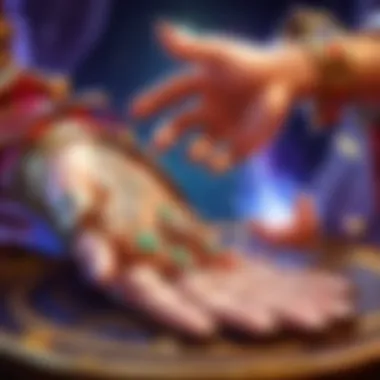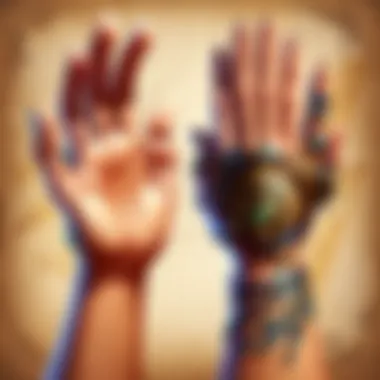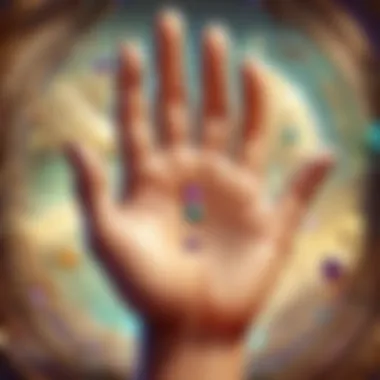Understanding Palm Reading: History, Techniques, and Ethics


Intro
Palm reading, also known as palmistry or chiromancy, is an ancient practice that people have utilized for centuries to gain insights about character and destiny. This storied tradition taps into a feeling of curiosity about the less tangible aspects of our selves and our future. While often viewed through a mystical lens, palm reading also encompasses historical and psychological elements, providing a rich field of exploration for individuals interested in personal development and introspection.
Historical Context
The practice of palm reading finds its roots deeply embedded in various cultures, such as Indian astrology, Chinese runes, and Greek philosophy. Each culture imposes its own interpretations onto intricate lines and shapes on the hand. Understanding the symbolic history strengthens one’s engagement and respect towards this form.
"To understand palmistry, one must recognize the myriad thoughts of connecting identity, universe, and fate together."
Palm Features and Their Significance
The palm presents numerous features that enthusiasts categorize into lines, mounts, and shapes. The three prominent lines are the heart line, head line, and life line. Each line holds cumulative meaning. Rise and fall in line quality can often suggest emotional health, decision-making process, and life events. Multiple mounts also present another level of interpretation centered around individual personality traits.
Techniques of Interpretation
Reading palms involves foundational techniques rather subjective opinions on traits represented by palm features. Techniques can vary; one may focus on creases, while another emphasizes fingertip lengths and thumb dexterity. Developing a systematic approach is vital. Engaging different techniques opens avenues to more profound understanding.
- Analysis of the dominant hand: Represents conscious, outward personality traits.
- Study of the non-dominant hand: Usually reveals the subconscious aspects.
Equally important is environment if that often mirrors societal expectations reflecting on lines that can shape due to various influences over time.
Ethical Considerations in Palmistry
As with any art, ethical considerations must never be overlooked. When reading palms, practitioners should be aware of implications and responsibilities. Respect for privacy is imperative; clients must feel comfortable sharing personal narratives based upon their palm if they so please.
Conclusively, it’s wise to be transparent regarding limitations and embrace opportunity for connection, aiming to heighten others’ self-awareness without reducing this explore practice to mere tricks. Incisive readings can contribute both inspiration and gentle awakening regarding choices and possibilities in life.
Preface to Palm Reading
Palm reading encompasses a rich tapestry of methodologies and philosophies that connect individuals to elements of self-discovery. Understanding this ancient practice is essential as it provides insight into not just personal traits and tendencies, but also the capacity for future growth. This section aims to delve into the fundamentals of palm reading, laying a robust foundation upon which more advanced topics can ponder.
Defining Palmistry
Palmistry, also known as chiromancy or palm reading, is the analysis of the lines, shapes, and markers located on a person's palms. While often seen as a mystical or esoteric practice, it offers significant potential for deeper self-awareness. It differs from mere fortune-telling, focusing instead on the intricate details that can reflect your internal landscape and sensitive dynamics. Palmistry does not determine fate; rather, it reveals patterns and tendencies that may help individuals explore their potential.
Historical Background
The origins of palmistry are complex, woven from various cultural threads over millennia. Evidence suggests its practice dates back to ancient civilizations in India, China, and Greece. In these societies, skilled readers offered their doumentation and insights as integral components of social and spiritual practices. During the Middle Ages, palmistry experienced scrutiny, often perceived as an occult practice linked to witches and sorcery. Yet, it managed to survive and evolve through the centuries, leading to facets of modern palm reading performed today.
“Palmistry has been practiced for thousands of years with varying interpretations across cultures.”
As society modernizes, palmistry retains relevance within therapeutic frameworks. Many individuals come to view it as a tool for reflection and understanding rather than absolute prediction, showcasing its adaptability across diverse contexts. The historical journey of palmistry highlights its rich heritage, underscoring the continuing intrigue it holds in contemporary times.
The Basics of Palm Anatomy
Understanding the anatomy of the palm is crucial for anyone seeking to interpret palm readings accurately. This section will explore the physical aspects that define palmistry, allowing readers to grasp the significance of different palm features. The function and shape of the palm play a vital role in revealing personality traits and potential life paths. Consequently, a foundational knowledge of palm structure enhances one’s reading skills and deepens one’s appreciation for this ancient practice.
Understanding Palm Shape
The shape of the palm can hint at various characteristics of an individual. There are generally four types of palm shapes: earth, air, water, and fire. Each shape corresponds, in terms of palmistry, to distinct personality traits. For instance, an earth palm is wide and square, signifying practicality and stability. An air palm tends to be long with a rectangular shape, hinting at intellectual pursuits.
A palm's shape can influence how other variables are weighted in readings. For example, fire palms may possess an exuberant temperament, whereas water palms may indicate sensitivity and intuition. Recognizing these shapes grant readers valuable insights that complement line and mount analysis.
Key Lines on the Palm


Palmistry emphasizes several key lines on the palm, particularly the heart line, head line, and life line. Each line holds diverse meanings and contributes individually to the overall interpretation of a palm.
Heart Line
The heart line is located along the top of the palm, curving towards the pinky. It signifies matters of love and relationships, reflecting emotional depth and capacity. Individuals often focus on this line due to its direct link to emotional experiences. A long, deep heart line suggests a passionate approach to love, while a short one may indicate more reserved feelings.
Its prominence allows the reader to determine relationship patterns and emotional stability, making this a key characteristic in palmistry. However, it is essential to interpret it in conjunction with other lines and palm features to gain a full understanding of romantic associations.
Head Line
Found below the heart line, the head line reveals aspects relating to intellect and decision-making processes. A straight and long head line generally implies a focus on logic and analytical thinking, while a curved line suggests a more creative approach to problem-solving. The distinct appearance of this line often influences its interpretation, providing a clear view of one's mental inclinations.
The head line's clarity adds layers to a reading, enabling insights into educational pursuits and style of communication. Thus, understanding its key traits is beneficial when examining how an individual interacts with their environment and makes choices.
Life Line
The life line arcs around the base of the thumb, portrayed as a crescent shape curving around the ball of the thumb. Often misinterpreted, the life line does not predict lifespan but indicates general well-being and vitality. Its depth and length often correlate to the energy level a person possesses, which can be assessed effectively in conjunction with other indicators.
A long life line may suggest a contact with life and its opportunities, yet a shorter nuanced line has no mere effect on longevity. The useful analysis that comes from noting variations allows deeper engagement with the reading process and reflects broader aspects of life experiences.
Mounts and Their Significance
Mounts, which are the fleshy areas at the base of the fingers, amplify the reading by offering insight into specific traits associated with each planet named to their position: Jupiter, Saturn, Apollo, Mercury, Venus, and Mars. Each mount contributes to a comprehensive interpretation by revealing key character traits and inherent inclinations.
For instance, an elevated mount can highlight strong personality traits or talents related to specific planets, guiding the reader toward understanding personal strengths and potential challenges.
Analyzing both palm lines and mounts creates a more unified picture, aiding in offering tailored readings aimed at personal growth or direction.
Techniques for Conducting a Palm Reading
Understanding the techniques for conducting a palm reading is essential for anyone serious about this practice. The very nature of palmistry relies not only on interpreting physical attributes but also on how one presents that reading. A comfortable setting can significantly enhance the reader's focus, thereby ensuring a more accurate interpretation. Likewise, the physical handling of the palm must be both respectful and clear. Each of these techniques offers unique benefits, contributing to the overall effectiveness of a reading.
Choosing the Right Environment
The environment in which a palm reading takes place can affect the experience for both the reader and the person having their palm read. A calm and quiet setting allows for better concentration and reduces distractions. Sometimes, even small elements, such as lighting or noise, can disrupt the delicate balance needed for a focused interpretation.
Consider the following tips when choosing an environment for palm reading:
- Dimmed Lighting: Soft lighting can create an intimate atmosphere.
- Comfortable Seating: Ensure that both the reader and the subject are at ease.
- Minimal Distractions: Make sure the space is void of interruption.
Creating the right environment not only facilitates better interpretation of palm features but also encourages openness between the reader and the individual.
How to Hold the Palm
Holding the palm correctly is crucial for obtaining a clear view of its lines, mounts, and overall shape. A secure yet gentle grasp prevents any involuntary stress or tension that might distort the reading. The subject should be comfortable with how their palm is being held, and the reader should find it stable enough to observe features without obstruction.
Best Practices of Holding the Palm:
- Rest Your Hands: Balance the subject's palm on your non-dominant hand for support.
- Gentle Grip: Use the dominant hand to guide and turn the palm to get different angles.
- Stay Calm: Your posture and demeanor can affect your subject’s comfort.
Maintaining a stead altitude of the palm helps in accessing two essential aspects: involvement of focuses on the singular attributes of the palm and making sure you project a relaxed atmosphere.
Interpreting Lines and Mounts
Interpreting the lines and mounts is where the heart of palm reading resides. Each line tells a tale of various aspects of life, and understanding their meanings is central to producing a significant reading. The confusion often arises with subtle variations and shapes within those lines. A systematic approach enhances clarity during the reading.
Key elements to consider include:


- Heart Line: Signals emotional depth and relationship dynamics.
- Head Line: Reflects intellectual capability and cognitive processes.
- Life Line: Regarded as an indicator of life vitality and overall health.
- Mounts: Named after planets, these areas can also reveal character traits depending on their prominence.
Overall, interpreting these factors requires sensitivity and insight, allowing you to paint a fuller picture for your subject.
Remember: The art of palm reading goes beyond mere lines; it incorporates both artistry and intuition. With careful techniques, anyone can learn to navigate these symbols effectively.
Advanced Palmistry Techniques
Advanced palmistry techniques extend beyond the basic principles of line and shape analysis, enriching the practice of palm reading. Understanding these techniques allows readers to delve deeper into the intricacies of palmistry, revealing more about an individual’s personality, potential life path, and emotional landscape. Utilizing advanced methods can enhance both the reader's skills and the overall experience for those seeking insights.
Minor Lines and Their Meanings
The minor lines on the palm hold significant details often overlooked in more general readings. While the three principal lines—Heart Line, Head Line, and Life Line—tend to draw the primary focus, minor lines can offer a wealth of information. These lines can provide context and nuances in the interpretation of the main lines. Some noted minor lines include:
- Fate Line: Reflects aspects of destiny and career progression.
- Sun Line: Connected to fame, creativity, and self-expression.
- Mercury Line: Relates to communications skill and quick wit.
While not everyone has all minor lines present, they serve to shape interpretations of personality traits and life events.
Each minor line serves a distinct purpose and reveals new facets to consider when appraising a palm. For instance, a clear Fate Line may indicate a defined career path, while its absence could suggest more flexibility in career choices.
Reading Fingertips and Nails
Fingertips and nails also provide valuable insights in palmistry. The shape, texture, and even color of nails can reflect emotional states and health issues. Distinct forms, such as square or round nail shapes, can indicate varying personality attributes and temperaments.
Moreover, analyzing the fingertips often leads to interpretations related to creativity and intelligence.
- Square Fingertips: Typically seen in practical and determined individuals.
- Pointed Fingertips: Likely associated with creative and idealistic traits.
Palmists can benefit significantly from careful observation of finger lengths and widths, especially in conjunction with palm analysis as a whole. In both cases, taking note of the details can result in more precise and richer readings that are tailored to the individual.
Observing the smaller features yields substantial context that enriches the reading experience for both parties involved.
Cultural Perspectives on Palm Reading
Exploring the cultural perspectives on palm reading is essential to understand its rich and diverse history. Traditions of palmistry have evolved significantly across various cultures. Each culture interprets palm features differently, leading to unique practices and beliefs. Understanding these perspectives provides valuable context for readers interested in palmistry today.
Western vs.
Eastern Palmistry
Palmistry in the Western world often emphasizes predictability and a structured framework approach. Practitioners analyze prominent lines, shapes, and mounts, offering insights into personality and potential life events. Some tend to rely heavily on scientific studies and data as proof for palm reading's validity. The fascination with Western palmistry stems partly from its connection with other metaphysical practices, such as astrology. With tools and systems developed over centuries, many Western practitioners lend credence to individuality, free will, and self-determination.
On the other hand, Eastern palmistry features a different methodology, deeply rooted in spiritual traditions. In countries like India, palm reading, or Sampoorna Hasta Siddhanta, connects with ideas of karma and reincarnation. The interpretation of the palm often addresses not just lived experiences but potential futures based on one’s past actions.
By examining both paradigms, readers can appreciate the fundamental principles behind palmistry and the unspoken influences of specific cultural contexts.
Palm Reading in Modern Times
In the present day, the popularity of palm reading spans across continents. This ancient art has found a revival, primarily thanks to social media and digital platforms. As people search for meaning and insights, palmistry presents itself as a tool for self-reflection. This resonates especially in a world increasingly disillusioned by traditional forms of counseling and guidance.
- The accessibility of palm reading workshops and online resources promotes interest.
- Services such as tarot and astrology are often combined with palmistry, indicating a growing holistic parenting.
- Enthusiasts turn to platforms like reddit.com for community discussions, ensuring collective learning.
Now more than ever, accuracy and ethics in palm reading are under scrutiny. Modern practitioners should remain sensitive to how interpretations could impact clients. Respecting personal information and setting clear boundaries are crucial practices in this realm of guidance.
“Understanding the historical context and cultural frameworks can enrich your experience with palmistry or even reshape personal beliefs.”
By acknowledging various cultural enriching layers, individuals willing to delve into palm reading can find a tailored approach that greatly enhances their understanding.
Ethical Considerations in Palm Reading


Palm reading, while often seen as a mystical practice, carries with it a weight of responsibility. Understanding ethical considerations is crucial for practitioners and those seeking readings alike. Handling a client's palm means more than just reading lines and mounts. It involves trust, safety, and respect. Ethical guidelines help define the practitioner-client relationship, creating a space where intentions are clear and where the practice can be both gratifying and constructive.
Setting Boundaries with Clients
Establishing boundaries is vital in palm reading. Clients often come seeking reassurance or direction, making them vulnerable. For practitioners, it is important to be clear about the scope of the reading. Discussing what the reading will entail beforehand sets expectations.
- Clarify the intention: Explain that palm reading isn't about absolute answers but insights.
- Communicate confidentiality: Assure clients that their readings will not be shared outside your sessions unless agreed otherwise.
- Define limitations: Let clients know that palm reading shouldn't replace professional advice from qualified specialist yere, such as doctors or therapists.
Fostering a transparent environment can prevent misunderstandings. Active listening will also help clients express their needs and concerns. Developing agreements on boundaries leads to a more productive experience for both parties.
Handling Sensitive Information
When reading palms, practitioners might encounter sensitive personal issues. Addressing how to manage this information with care is essential. Keeping in mind the following aspects can help retain trust:
- Refrain from oversharing: Only speak about impressions that pertain directly to the client's readings as openness might complicate matters.
- Keep discussions professional: If a client divulges personal information, steer the conversation back to palm analysis without engaging too deeply in their life stories. This maintains the integrity of the reading process.
- Offer resources: If significant themes arise during the reading, suggest applicable resources where clients can seek additional help without imposing.
Ensure discretion. Understanding when to advise clients to seek professional guidance speaks to your ethical principles and enhances their trust in your skills.
By adhering to these ethical considerations, palm readers can provide meaningful insights while nurturing a respectful and compassionate relationship with clients.
Practical Applications of Palm Reading
Palm reading, while often viewed as a mystical pastime, also holds several practical applications in modern life. Understanding these applications enhances not only the practice itself but also the significance it brings to insights regarding the self and our interactions with others. This section explores two primary applications: self-reflection and growth, as well as using palmistry in consultation settings.
Self-Reflection and Growth
One of the most profound aspects of palm reading is its potential for self-reflection. By examining one's own palms, individuals can uncover personal patterns, strengths, and areas for improvement. Unlike mere horoscope readings, palmistry provides a tangible medium through which a person can assess their own characteristics interpreting specific lines and mounts.
Research suggests that engaging in self-reflection can lead to increased emotional intelligence and resilience. When reading their palms, individuals may closely consider the Heart Line, the Head Line, and even the Life Line in relation to formative life events. This can ignite a deeper understanding of past choices and future aspirations. Simple observations like how deep or tangled the lines are may prompt reflections upon one’s emotional state, thought processes, or overall life structure.
“Palm reading can be a mirror to the self, showing paths taken and those yet to be explored.”
To maximize this growth process, it can be beneficial to journal entries following a reading session. Note any revelations, concerns or insights that rise. This practice not only solidifies the readings, but serves as a personalized tool for ongoing growth.
Using Palmistry in Consultation Settings
Consultation settings represent another practical facet of palm reading, applying it to enhance communication and understanding in varied scenarios. Palmists have often utilized this technique in professional environments such as coaching, counseling, and even workplace synergy modeling. Being able to understand a client or colleague's thinking style and emotional responses through their palm can richly inform the interaction.
In these environments, readings might extend beyond individual characteristics. For instance:
- Facilitating Personal Development: Guiding individuals towards unique pathways to reach their goals.
- Team Dynamics: Understanding varying personalities within a group based on palm characteristics, leading to stronger unity.
- Conflict Resolution: Using palm readings to bridge gaps in communication styles between people.
Training in palmistry within consultation practices therefore holds substance for ground level communication and can open the door for effective teamwork. By framing sessions around palms, professionals can actively engage individuals in discussing perceived traits highlighted in their lines and mounts, thus enriching the consulting experience altogether.
To conclude, the practical applications of palm reading stretch far beyond fortune-telling or entertainment. As self-reflection boosts personal growth, its strategic application in consultation settings fosters a deeper understanding that leads to improved relationship and team dynamics.
The End
The conclusion serves as a vital component in this article, synthesizing information that demonstrates the significance of palm reading in various contexts. Palmistry is not merely a foretelling practice; it has been intertwined with human inquiry for centuries. As we reflect on the intersections of science, art, and spirituality, one must acknowledge how this fusion leads individuals to deeper self-understandings.
Summarizing Key Points
As we examine the full scope of palm reading, it is essential to highlight several key points:
- Historical Context: Palmistry has roots that extend back to ancient civilizations, offering insights into the beliefs and practices of different cultures.
- Palm Anatomy: Understanding the hand's shape, lines, and mounts is foundational. Each feature provides a narrative waiting to be interpreted.
- Techniques: Proper methods for reading palms can greatly affect the outcome. An optimal setting and approach maximize clarity in readings.
- Cultural Perspectives: Variations between Western and Eastern influences showcase the diversity of interpretations and practices in palmistry.
- Ethical Considerations: Setting appropriate boundaries is crucial in maintaining integrity while handling sensitive information.
- Practical Applications: Palm reading enables self-reflection and potential personal growth for both readers and subjects.
Future Directions in Palmistry Studies
Looking towards the future of palmistry studies, persistence in exploring contemporary frameworks for interpretation can enhance its practice. First, researchers can integrate palmistry with psychological frameworks to understand better how individuals relate to their palm features. Ground-breaking academic study is lagging in this domain, warranting rigor.
Moreover, advancements in digital technology offer tools that may revolutionize how palm readings are conducted and shared. Online forums on social platforms establish communities excited to discuss and develop their proficiency. Including tools for feedback continues evolving this ancient practice into modern contexts.
As we endeavor to continue this exploration, it's clear palmistry remains a focus not only for fortune-telling but also to foster personal insight. For new and seasoned practitioners alike, an horizon of possibilities awaits further understanding of the human experience through the lines on one's palm.







